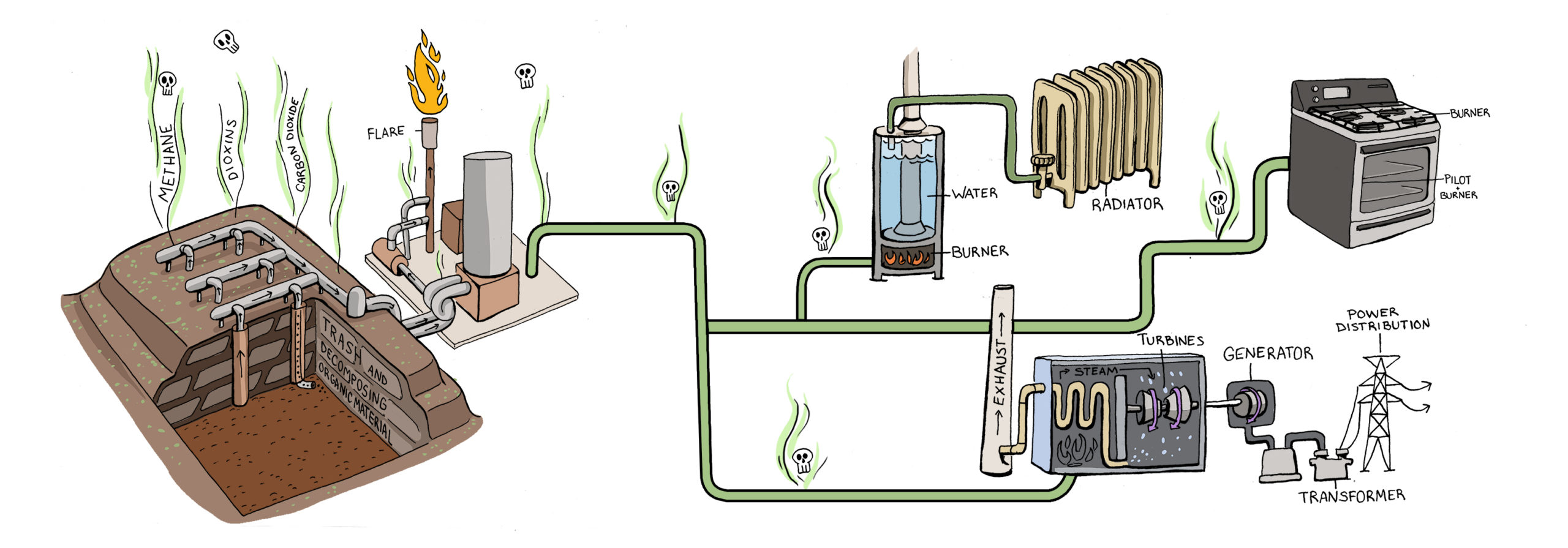Landfills are the third largest human-made source of methane in the world, after livestock and natural gas.[1], [2] Landfill gas is about half methane and half carbon dioxide (CO2), laced with hundreds of toxic contaminants, including methylmercury and many chlorinated chemicals that can form highly toxic dioxins when burned (see Waste Incineration). Radioactive tritium is also increasingly found in landfill gas, from emergency exit signs and other sources.[3] Methane is a greenhouse gas, 86 times more potent than CO2 over a 20-year period.[4] It is produced when organic discards (food scraps, paper and wood products, yard waste, sewage sludge) decompose in an oxygen-starved environment.
In the United States, larger landfills are required to capture landfill gas (and usually burn it), but capture systems are only partially effective. Landfills claim that they typically capture about 75% of their gas,[5], [6] but reality can be much lower.[7], [8] Much of the gas escapes as fugitive emissions, causing cancers and other health problems in neighboring communities.[9]
Many landfills burn gas in a flare, while others burn it to make heat or electricity, or clean it up to feed into natural gas pipelines. These are called Landfill Gas-To-Energy (LFGTE). Burning the gas converts most of the methane to CO2, drastically reducing the global warming impacts. While breaking down some pollutants in the gas, it also produces new ones like nitrogen oxides that trigger asthma attacks and ultra-toxic dioxins.[10]
LFGTE projects receive many state and federal subsidies. Climate and energy policy-makers are lobbied by the waste industry to subsidize landfills and incinerators instead of supporting zero waste solutions like composting and recycling. As a result, some communities even cancel composting programs to dump more organics in landfills to maximize LFGTE opportunities.[11], [12] Nearly 90% of materials discarded in landfills and incinerators can be recycled or composted.[13] Typically competing with wind and solar in renewable energy mandates, landfills also absorb subsidies that ought to flow to these cleaner non-burn alternatives.
Ironically, burning landfill gas for energy can be worse than simply burning off the gas.[14] Managing landfills as energy facilities encourages the mismanagement of landfills to make them more gassy, when a proper waste system would do the opposite. Food scraps, yard waste and other clean organic materials should be separated at the source and aerobically composted. The dirty remaining organic materials in the trash and sewage sludge should be anaerobically digested to stabilize it before landfilling to avoid methane generation in landfills, where gas is harder to capture.[15]
Energy Justice Network: energyjustice.net/lfg
Global Alliance of Wastepickers: globalrec.org
[1] Global Methane Initiative. (n.d.). Global methane emissions and mitigation opportunities. http://globalmethane.org/documents/analysis_fs_en.pdf
[2] U.S. Energy Information Administration. (2011, March 31). Greenhouse gas emissions – methane emissions. http://eia.gov/environment/emissions/ghg_report/ghg_methane.php
[3] Mutch, R. D., Mahony, J. D., Paquin, P. R., & Cleary, J. (2007). A study of tritium in municipal solid waste leachate and gas. Proceedings of the Water Environment Federation, 6, 283-295. http://doi.org/10.2175/193864707786542625
[4] Energy Justice Network. (2018, July) Methane’s global warming potential (number of times worse than CO2). http://energyjustice.net/naturalgas#GWP
[5] West Coast Climate and Materials Management Forum. (n.d.). Gas capture rates: Uncertainty involving landfill gas emissions. http://westcoastclimateforum.com/content/gas-capture-rates-uncertainty-involving-landfill-gas-emissions
[6] Electronic Code of Federal Regulations. (2021, February 25). Table HH-3 to subpart HH of part 98—Landfill gas collection efficiencies. http://ecfr.gov/cgi-bin/retrieveECFR?gp=&SID=765d2acc0741856732928caf2dd0d49e&mc=true&n=sp40.23.98.hh&r=SUBPART&ty=HTML#ap40.23.98_1348.3
[7] Witynski, M. (2019, July 12). Disputed ground: The future of landfill gas-to-energy. Waste Dive. http://wastedive.com/news/disputed-ground-the-future-of-landfill-gas-to-energy/557706/
[8] Energy Justice Network. (2020, September) Landfill gas-to-energy: Toxic and bad for the climate… Not green or renewable. http://energyjustice.net/lfg
[9] Lewis-Michl, E.L., Kallenbach, L.R., Geary, N.S., Melius, J.M., Ju, C.L., Orr, M.F., & Forand, F.P. (1998). Investigation of cancer incidence and residence near 38 landfills with soil gas migration conditions: New York State, 1980-1989. New York State Department of Health, Division of Occupational Health and Environmental Epidemiology, Bureau of Environmental and Occupational Epidemiology. http://energyjustice.net/files/lfg/nys-cancer.pdf
[10] Caponi, F. R., Wheless, E., & Frediani, D. (1998). Dioxin and furan emissions from landfill gas-fired combustion units. County Sanitation Districts of Los Angeles County. http://energyjustice.net/files/lfg/LFG-caponi.pdf
[11] Kolker, K. (2019, April 4). Lifting yard waste ban may help landfill gas be greener. MLive. http://mlive.com/grpress/2008/06/lifting_yard_waste_ban_may_hel.html
[12] Public Sector Consultants Inc. (2017, January) Policy brief on “examining increased renewable energy production from landfill gas in Michigan.” http://publicsectorconsultants.com/wp-content/uploads/2017/01/Granger_PolicyBrief-1.pdf
[13] Barnes, J. (2015, June 23). About 90% of waste sent to landfill could be recycled or composted. Waste Dive. http://wastedive.com/news/about-90-of-waste-sent-to-landfill-could-be-recycled-or-composted/401156/
[14] Stewart, J. R. (2013). Landfill gas-to-energy projects may release more greenhouse gases than flaring. http://energyjustice.net/files/lfg/lfgte-increases-ghgs.pdf
[15] Morris, J., Favoino, E., Lombardi, E., & Bailey, K. (2013). What is the best disposal option for the “Leftovers” on the way to Zero Waste? Eco-Cycle. http://ecocycle.org/specialreports/leftovers

